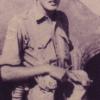We moved off from the DZ at about, I should imagine, 02.40 hours and contacted the Brigade Commander on the bridges. After a few words with him we went over the bridges, seeing Howard on the way.
At this time I had very few men, only about 30. I got another 20 on the other side of the bridges; we then cut across the back of the Maire. After searching that we went up the Caen road into Benouville.
I had Sgt Willis’ platoon leading, then Company HQ with Bowyer with me and his platoon behind, then David Hunter and his platoon. As Willis’ leading man got to the main cross roads of the village a motor cyclist came round the corner from the East and down the road towards us. Everybody fired at him and he crashed just behind me. Bill Bowyer’s runner, or batman, fired at him too when he was on the ground and unfortunately Bill was hit and died later.
I ordered Willis into the houses on the South end of the village and Hunter into the farm buildings to the West. Company HQ went into the gardens of the houses on the other side of the road and the remains of Bowyer’s platoon into the houses to the East of that.
Things were fairly quiet until first light. We could then hear vehicles moving (tracked) on the Caen road and were ready for armour. The enemy started up just before first light (about 04.00 hours?) firing down the road with his SP guns and trying to infiltrate infantry round our West (right) flank. The latter were effectively held off all day by Hunter.
The houses on the forward edge (South) of the village became untenable, because we had nothing with the range to keep the SP’s quiet, so Willis had to be retired into houses further back. The Boche then penetrated into the village with SP’s, tanks and an armoured car.
Company HQ had, by this time, moved to the right of the road (West) and so had the remains of Willis’ platoon, I had to move these later as I could hear the battle going on in 'B' Company’s area and, on one occasion, a German Mk IV tank came through from that direction. This was slightly shaking, but we got it with about 4 gammons and were pleased to see him on fire. The SP was still firing straight down the road, but couldn’t hit any of us, except Jim and I!
The position then was that we were holding a sort of reverse slope position behind the village. It was remarkably effective. The Germans couldn’t get at us, but if he tried to infiltrate we had the field of fire and got him immediately. Our men realised their position in a remarkable way and were extremely alive to the danger of letting any enemy get into a fire position. We had snipers in odd houses who gave the general run of the battle by shouting so that most could hear (we were in an extremely tight locality). Mortar fire was not particularly effective against us but, of course, casualties grew slowly and rather inexorably during the day.
In the afternoon we were greatly cheered to see two Shermans come up to us – the place was alive with yellow smoke, yellow triangles and red berets on sticks – but without contacting us they went straight on and were never seen by us again. Things were quiet for about half an hour after their appearance. I believe they got brewed up further down the road.
The Germans never knew what strength we had. They never really launched an all out attack as we would understand it. Plenty of fire, yes, and Verey lights, but no men or bayonets. We expected it every time things brewed up, but it never came. If they had really tried to outflank us they would have made it extremely awkward for us.
We were eventually relieved in the evening and our wounded got out by the scout cars. The Germans never fired at these wounded being evacuated.
Note: Major Taylor was badly wounded in the leg early in the action, but continued to influence the battle from a stretcher.
Active command was exercised by Capt J.J. Webber, the company second-in-charge, who although wounded himself, more than once, retained the use of his legs. He is the officer referred to as Jim in Taylor’s account.
The officer referred to as Howard was Major Howard the commander of the 'coup de main' party.
Gammons are the special tank busting bomb carried by parachutists. Named after Lieut GAMMON, himself a parachutist, who invented it. It utilised the two pounds of plastic explosive which is carried in action by all parachutists. It was an effective weapon provided the thrower was within close range of the tank.
By Bob Hilton
Source: John Taylor for Staff College.
Read More




Latest Comments
There are currently no comments for this content.
Add Comment
In order to add comments you must be registered with ParaData.
If you are currently a ParaData member please login.
If you are not currently a ParaData member but wish to get involved please register.